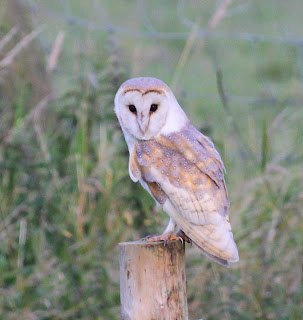It rained on and off all morning so I left the birding and the walks through long grass for later. It felt a bit like work in the sunny but breezy afternoon as I lugged a ladder across the field and erected 6 more nest boxes designed for Tree Sparrows, then checked the other boxes already there. I missed the first broods because I was away in Menorca but there are already three boxes with new eggs and four other nests flattened by now fledged young where the females will probably lay again. Already a couple of my precious hours had disappeared.
Armed with a Schedule One licence I went to check the Barn Owl box put up a few years ago, and my hopes rose as 2 Barn Owls flew from the barn as soon as I entered. Climbing up to the box but with the owls long gone there was no need to tap the timber so as I stuck a torch in, searching around for eggs or small young. The box had neither eggs nor young, just piles of pellets on the floor of the barn below where the owls had spent many hours roosting in the undisturbed building. One of the owls flew across to a nearby fence and watched me for a second or two before it hurried off elsewhere.


A pellet is the mass of undigested parts of a bird's food that some bird species occasionally regurgitate. The contents of a bird's pellet depend on its diet, but can include the skeletons of insects, indigestible plant matter, bones, fur, feathers, bills, claws, and teeth. The passing of pellets allows a bird to remove indigestible material from its glandular stomach. In birds of prey, the regurgitation of pellets serves the bird's health by "scouring" parts of the digestive tract, including the gullet. Pellets are formed within six to ten hours of a meal in a bird’s gizzard.
I drove on to the farm at Out Rawcliffe and checked out the Whitethroat nest found a few weeks ago at the egg stage. At last the four young were now just the right size for ringing, with an unhatched egg still deep in the nest.

Deeper into the plantation I watched a pair of Willow Warblers that eventually gave away the location of their nest with 5 young, again an ideal size for ringing.

I glanced at my watch and it was 1650, and oh boy how time flies when having fun. But with birding there really is always tomorrow.































































